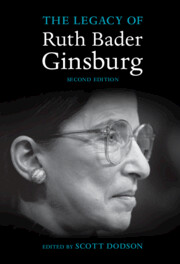Book contents
- The Legacy of Ruth Bader Ginsburg
- The Legacy of Ruth Bader Ginsburg
- Copyright page
- Contents
- Contributors
- Preface
- Foreword
- Acknowledgments
- Introduction to the Second Edition
- Part I Shaping a Legacy
- Part II Rights and Remedies
- 6 “Seg Academies,” Taxes, and Judge Ginsburg
- 7 A More Perfect Union
- 8 Barriers to Entry and Justice Ginsburg’s Criminal Procedure Jurisprudence
- 9 A Liberal Justice’s Limits
- Part III Structuralism
- Part IV The Jurist
- Notes
- Index
8 - Barriers to Entry and Justice Ginsburg’s Criminal Procedure Jurisprudence
from Part II - Rights and Remedies
Published online by Cambridge University Press: 03 March 2022
- The Legacy of Ruth Bader Ginsburg
- The Legacy of Ruth Bader Ginsburg
- Copyright page
- Contents
- Contributors
- Preface
- Foreword
- Acknowledgments
- Introduction to the Second Edition
- Part I Shaping a Legacy
- Part II Rights and Remedies
- 6 “Seg Academies,” Taxes, and Judge Ginsburg
- 7 A More Perfect Union
- 8 Barriers to Entry and Justice Ginsburg’s Criminal Procedure Jurisprudence
- 9 A Liberal Justice’s Limits
- Part III Structuralism
- Part IV The Jurist
- Notes
- Index
Summary
In her nearly thirty years on the United States Supreme Court, Justice Ruth Bader Ginsburg issued momentous decisions and significant dissents concerning constitutional guarantees of equality. She is best known for her leadership – as an advocate, scholar, judge, and justice – on issues of gender discrimination. Although one might expect related commitments to civil liberties to shape cases concerning the criminal justice process, Justice Ginsburg’s mark on constitutional criminal procedure appears comparatively faint.
- Type
- Chapter
- Information
- The Legacy of Ruth Bader Ginsburg , pp. 94 - 107Publisher: Cambridge University PressPrint publication year: 2022

